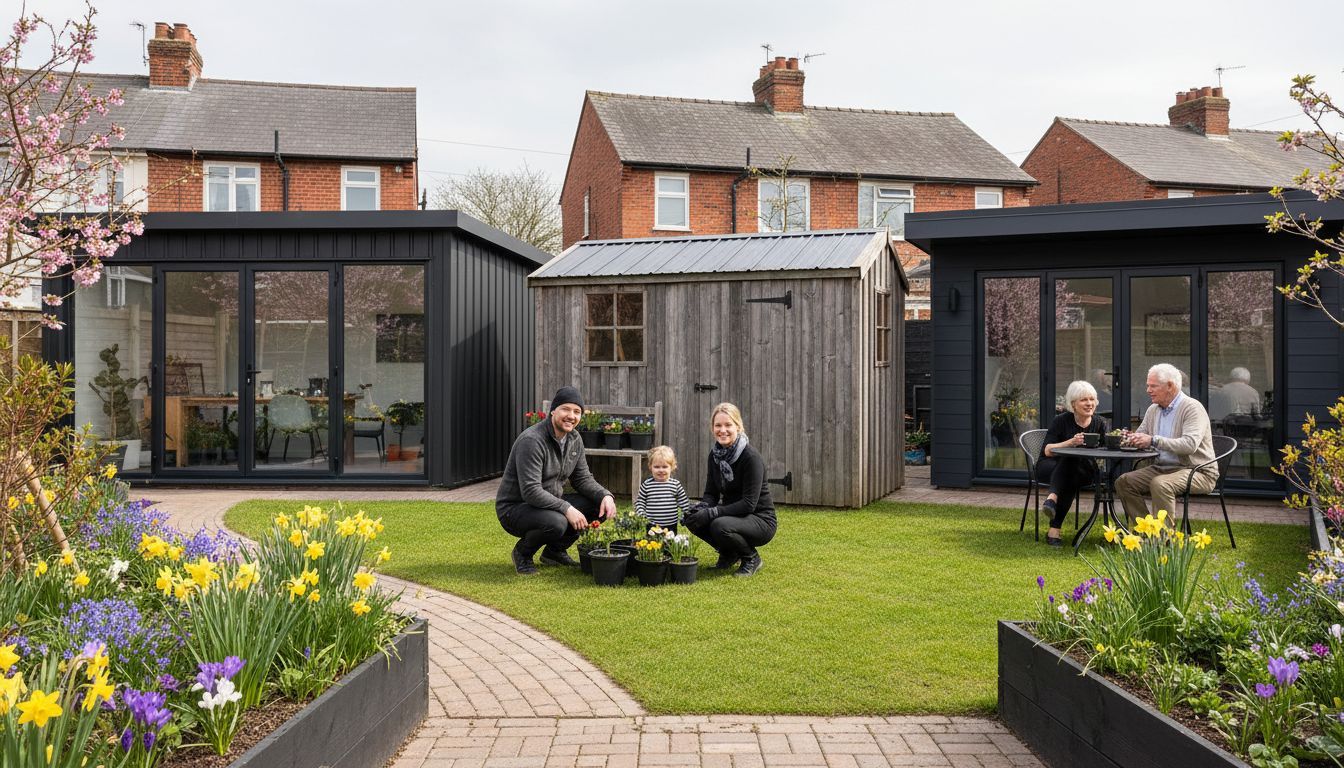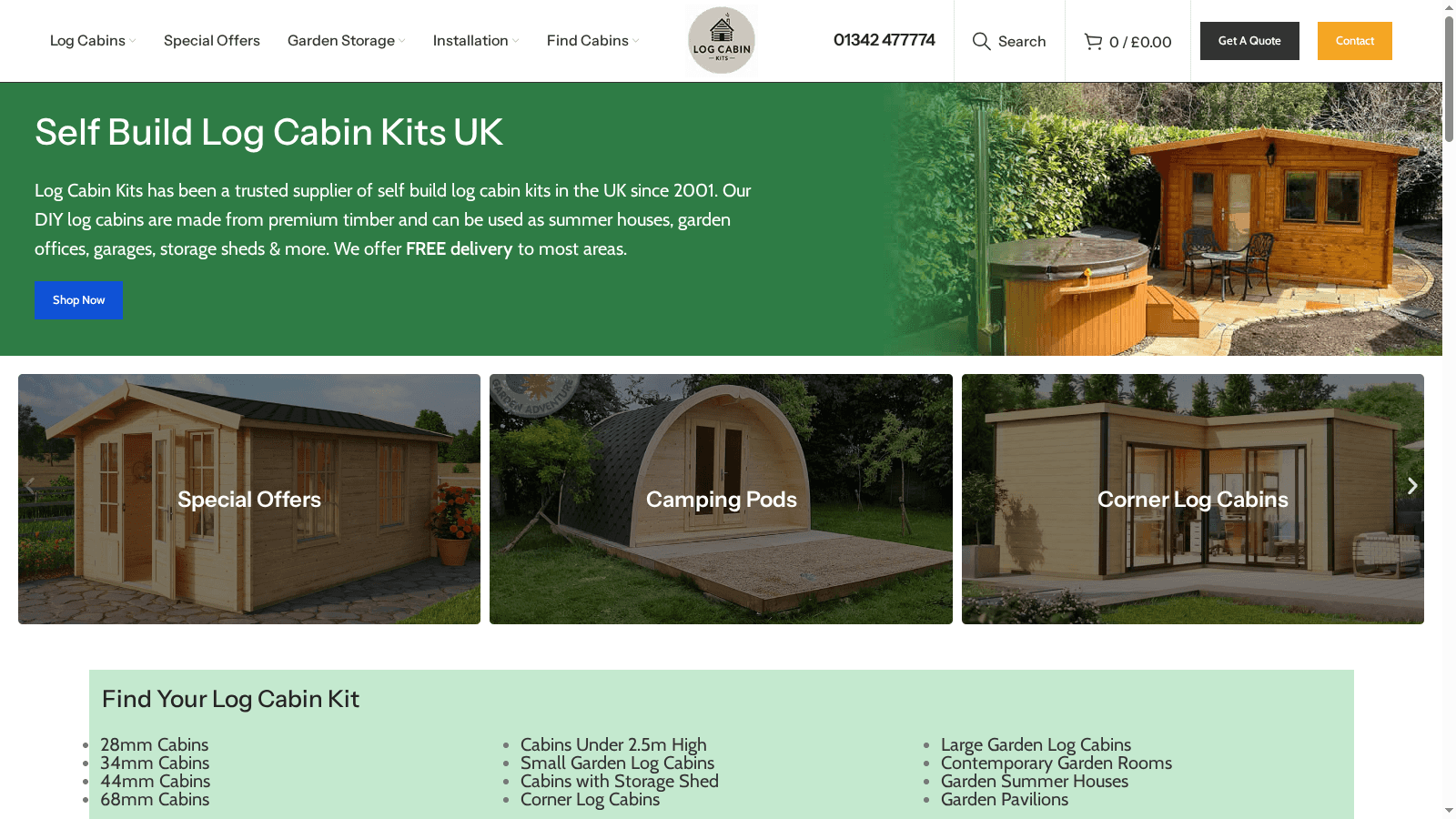Blog
Call Now 01342 477774
7 Best Garden Buildings 2025 for UK Garden Lovers

The british love of gardens is clear in every neighbourhood, yet finding the right garden building for your space is not always simple. With over 40 percent of homeowners seeking to enhance their outdoor areas each year, the choices you make can shape both the look and daily use of your property. This guide will help you match style, durability, and function so your garden building stands strong through every british season.
Table of Contents
- 1. Choosing The Right Size For Your Garden Space
- 2. Benefits Of Custom And Bespoke Garden Buildings
- 3. Energy-Efficient Features For Modern Garden Rooms
- 4. Best Materials For Durability In UK Weather
- 5. Maximising Storage And Multi-Use Functionality
- 6. Easy Planning Permission Tips For 2025
- 7. Seasonal Maintenance For Long-Lasting Use
Quick Summary
| Key Insight | Explanation |
|---|---|
| 1. Size Your Garden Building Wisely | Choose dimensions that suit your garden size and intended use to enhance functionality and aesthetics. |
| 2. Embrace Customisation Benefits | Opt for bespoke garden buildings tailored to your needs, enhancing aesthetics and property value. |
| 3. Prioritise Energy Efficiency | Implement high-quality insulation and sustainable heating solutions to reduce energy costs in your garden room. |
| 4. Choose Durable Materials | Select weather-resistant materials like pressure-treated timber and composite cladding for longevity. |
| 5. Stay Informed on Planning Rules | Understand local regulations on garden buildings to avoid complications and ensure smooth construction. |
1. Choosing the Right Size for Your Garden Space
Selectin the perfect garden building size can make or break your outdoor space transformation. Understanding how to match your garden room dimensions with your available area and intended use is crucial for creating a functional and harmonious addition to your property.
According to the Essex Design Guide, garden buildings should occupy no more than two fifths of your total garden space. This recommendation ensures you maintain adequate sunlight and preserve room for other garden activities.
Key Considerations for Garden Building Sizing
When determining the right size, consider these essential factors:
- Purpose of the Building: A compact home office might require only 2.5m x 2.5m, while a gym or studio could need around 4m x 5m.
- Garden Dimensions: Measure your total garden area and plan accordingly.
- Planning Regulations: Ensure your garden building does not exceed 50% of available space to avoid requiring additional planning consent.
Practical tip: Always leave sufficient surrounding space for garden maintenance, plant growth, and natural light penetration. A well positioned garden building should complement your outdoor environment, not overwhelm it.
For more detailed guidance on planning your garden space, check out our Space Planning for Garden Buildings comprehensive guide.
2. Benefits of Custom and Bespoke Garden Buildings
Custom garden buildings represent far more than simple structures they are personalised extensions of your living space that can transform how you use your outdoor area. Imagine a garden room that perfectly matches your lifestyle needs while seamlessly blending with your property’s unique character.
According to Garden Advice, bespoke garden rooms offer complete design freedom, allowing extraordinary flexibility in creating multipurpose spaces tailored precisely to your requirements.
Key Advantages of Bespoke Garden Buildings
When considering a custom garden building, you unlock several significant benefits:
- Design Flexibility: Create a space that perfectly matches your aesthetic and functional needs
- Property Value Enhancement: Well designed garden rooms can increase your home’s market appeal
- Personalised Functionality: Combine multiple purposes such as a home office and yoga studio
- Planning Compliance: Custom designs can meet specific local planning requirements
Practical considerations matter. A bespoke garden building allows you to maximise every square metre of your outdoor space, creating a solution that feels like a natural extension of your home rather than an awkward additional structure.
For deeper insights into planning your ideal garden building, explore our Bespoke Garden Buildings Complete UK Guide to help you make an informed decision.
3. Energy-Efficient Features for Modern Garden Rooms
As energy costs continue to rise, creating an efficient garden room has become more crucial than ever for UK homeowners. Modern garden buildings are no longer just additional spaces but intelligent, thermally optimised environments that can significantly reduce your energy consumption.
Key Energy Efficiency Strategies
When designing your garden room, consider these essential energy-saving features:
- Superior Insulation: Invest in high quality wall, floor, and roof insulation to minimise heat loss
- Double or Triple Glazing: Install windows with advanced glazing to prevent thermal transfer
- Sustainable Heating Solutions: Explore options like infrared panels or air source heat pumps
- Intelligent Ventilation: Incorporate systems that maintain air quality while preventing heat escape
Practical implementation involves thinking holistically about your garden room. Materials matter. Opt for sustainable timber frames, use eco friendly sealants, and consider orientation to maximise natural sunlight and warmth.
For comprehensive insights into maintaining optimal temperatures in your garden building, explore our guide on Energy-Efficient Heating Options to help you make informed decisions about your garden room’s thermal performance.
4. Best Materials for Durability in UK Weather
In the unpredictable British climate, selecting the right materials for your garden building is not just a choice it is a necessity. Your garden room needs to withstand everything from persistent rainfall to occasional frost and unexpected temperature fluctuations.
Essential Material Considerations
When choosing materials that can endure the UK’s challenging weather conditions, focus on these critical elements:
- Pressure Treated Timber: Offers superior resistance against moisture and potential rot
- Cedar Wood: Natural oils provide excellent weather protection and minimal maintenance
- Composite Cladding: Combines durability with low maintenance requirements
- Aluminium Framing: Provides structural integrity and rust resistance
The key is selecting materials that offer a balance between aesthetic appeal and practical resilience. Timber treatments matter significantly. Opt for wood that has been professionally pressure treated or has inherent weather resistant properties.
To understand more about creating a long lasting garden building that can weather the British elements, explore our comprehensive guide on The Durability of Garden Log Cabins for expert insights into material selection and preservation techniques.
5. Maximising Storage and Multi-Use Functionality
The modern garden building is no longer just a static structure but a dynamic, adaptable space that can transform to meet your evolving lifestyle needs. Smart design and strategic planning can turn your garden room into a versatile sanctuary that serves multiple purposes.
According to Steel Frame Buildings, bespoke garden rooms can be ingeniously transformed into various functional spaces including home offices, playrooms, gyms, studios, or guest rooms.
Smart Storage and Functionality Strategies
Consider these approaches to maximise your garden building’s potential:
- Modular Furniture: Invest in flexible, movable pieces that can be reconfigured easily
- Built In Storage Solutions: Integrate custom shelving and hidden compartments
- Multipurpose Design Elements: Select furniture that serves dual functions
- Vertical Space Utilisation: Implement wall mounted storage and folding systems
Practical implementation means thinking creatively about your space. A desk that folds into a wall can transform a home office into an exercise area. Clever built in storage can help you maintain a clutter free environment while maximising every square centimetre of your garden room.
For more detailed insights into creating a truly versatile garden building, explore our guide on Why Build a Multi Purpose Garden Building.
6. Easy Planning Permission Tips for 2025
Navigating planning permissions for garden buildings can seem like a complex maze, but understanding the current regulations can transform your project from a potential headache to a smooth experience. The key is knowing exactly what you can build without requiring formal approval.
According to Nanny McPhee, many garden room constructions fall under England’s permitted development rights, provided they respect specific height, footprint, and usage regulations.
Critical Planning Permission Insights
To ensure a hassle free garden building project, consider these essential tips:
- Height Restrictions: Ensure your structure is no taller than 2.5 metres at the eaves
- Footprint Limitations: Keep the total area under 30 square metres
- Location Considerations: Position the building at least 2 metres from any property boundary
- Usage Compliance: Confirm the building is for personal use, not commercial purposes
Practical preparation means anticipating potential challenges. Document every aspect of your planned garden building, take accurate measurements, and consider consulting local planning authorities for specific guidance.
For comprehensive guidance through the planning permission process, explore our Guide on Log Cabin Planning Permission to navigate the regulations with confidence.
7. Seasonal Maintenance for Long-Lasting Use
Your garden building represents a significant investment that requires thoughtful, consistent care to preserve its beauty and functionality through changing British weather conditions. Proactive seasonal maintenance can extend your structure’s lifespan and prevent costly repairs down the line.
Comprehensive Seasonal Maintenance Strategies
Implement these essential maintenance practices throughout the year:
- Spring Inspection: Check for winter damage, repair any water infiltration points
- Summer Protective Treatment: Apply wood sealants and UV protective coatings
- Autumn Weatherproofing: Clear gutters, inspect roof and seal potential entry points
- Winter Preparation: Ensure proper insulation and minimise moisture accumulation
Practical maintenance means being attentive and systematic. Regular visual inspections can catch potential issues before they become significant problems. Pay special attention to joints, seals, and areas exposed to direct rainfall or prolonged moisture.
To dive deeper into preserving your garden building, check out our comprehensive guide on Building Resilience for Your Garden Building for expert maintenance insights.
This table summarises the key points regarding garden buildings, from choosing the right size to energy efficiency, materials, storage, planning permission, and maintenance.
| Topic | Description | Key Considerations |
|---|---|---|
| Choosing Size | Match garden building dimensions to space and use. | Purpose, garden size, regulations; leave space for sunlight and maintenance. |
| Custom Buildings | Tailored designs that enhance property value. | Design flexibility, multi-use functionality, planning compliance. |
| Energy Efficiency | Effective insulation and heating to reduce costs. | Insulation, glazing, sustainable heating, ventilation. |
| Durable Materials | Select materials that withstand UK weather. | Pressure treated timber, cedar wood, composite cladding, aluminium framing. |
| Maximising Functionality | Transform space with smart design. | Modular furniture, built-in storage, multipurpose elements. |
| Planning Permission | Understand regulations for hassle-free building. | Height, footprint, location, personal use compliance. |
| Seasonal Maintenance | Routine care for longevity. | Inspections, protective treatments, weatherproofing, insulation. |
Transform Your Outdoor Space with the Perfect Garden Building
Selecting the ideal garden building is a challenge many UK homeowners face as they seek to maximise their garden’s potential while ensuring durability and energy efficiency. Whether you want a bespoke multi-use room or a practical, weather-resistant cabin, understanding size, materials and planning permissions plays a vital role in achieving your dream space. The key pain points include fitting your garden building within permitted development rights, creating versatility through smart storage, and securing a design that blends elegance with resilience against the British climate.

Explore our broad range of customised garden buildings at Log Cabin Kits where you can find expert solutions tailored to your lifestyle needs. Gain valuable insights by visiting our guides on Bespoke Garden Buildings Complete UK Guide and learn how to maximise your garden space with Space Planning for Garden Buildings. Act now to create a stunning and functional outdoor retreat that lasts for years to come and transforms your garden into the perfect sanctuary.
Frequently Asked Questions
Bespoke garden rooms, studios, and home offices are popular options for maximising your outdoor area. Evaluate your needs and preferences to select the type that suits your lifestyle best.
Choose materials and designs that complement your property’s architecture and garden aesthetics. Visualise the overall look by sketching or using online design tools to see how different styles will integrate with your outdoor space.
Aim for a size that does not exceed two fifths of your total garden space to maintain light and room for other activities. Measure your available area and consider the building’s primary function when determining the dimensions.
Conduct seasonal maintenance by inspecting for damages in spring, treating surfaces in summer, weatherproofing in autumn, and ensuring proper insulation in winter. Establish a checklist for each season to streamline your maintenance efforts.
Incorporate high-quality insulation, double or triple glazing, and sustainable heating solutions to enhance energy efficiency. Evaluate options like solar panels or air source heat pumps to further reduce energy consumption.
Design your space with modular furniture and built-in storage solutions to create a multi-use environment. Consider including elements that can serve dual purposes, like a desk that folds away to create more space when needed.
